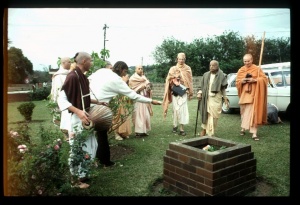SB 4.24.64

A.C. Bhaktivedanta Swami Prabhupada
TEXT 64
- sṛṣṭaṁ sva-śaktyedam anupraviṣṭaś
- catur-vidhaṁ puram ātmāṁśakena
- atho vidus taṁ puruṣaṁ santam antar
- bhuṅkte hṛṣīkair madhu sāra-ghaṁ yaḥ
SYNONYMS
sṛṣṭam — in the creation; sva-śaktyā — by Your own potency; idam — this cosmic manifestation; anupraviṣṭaḥ — entering afterward; catuḥ-vidham — four kinds of; puram — bodies; ātma-aṁśakena — by Your own part and parcel; atho — therefore; viduḥ — know; tam — him; puruṣam — the enjoyer; santam — existing; antaḥ — within; bhuṅkte — enjoys; hṛṣīkaiḥ — by the senses; madhu — sweetness; sāra-gham — honey; yaḥ — one who.
TRANSLATION
My dear Lord, after creating by Your own potencies, You enter within the creation in four kinds of forms. Being within the hearts of the living entities, You know them and know how they are enjoying their senses. The so-called happiness of this material creation is exactly like the bees' enjoyment of honey after it has been collected in the honeycomb.
PURPORT
The material cosmic manifestation is an exhibition of the external energy of the Supreme Personality of Godhead, but because dull matter cannot work independently, the Lord Himself enters within this material creation in the form of a partial expansion (Paramātmā), and He enters also by His separated parts and parcels (the living entities). In other words, both the living entities and the Supreme Personality of Godhead enter into the material creation just to make it active. As stated in Bhagavad-gītā (BG 7.5):
- apareyam itas tv anyāṁ
- prakṛtiṁ viddhi me parām
- jīva-bhūtāṁ mahā-bāho
- yayedaṁ dhāryate jagat
"Besides this inferior nature, O mighty-armed Arjuna, there is a superior energy of Mine, which consists of all living entities who are struggling with the material nature and are sustaining the universe."
Since the material world cannot work independently, the living entities enter into the material manifestation in four different types of bodies. The word catur-vidham is significant in this verse. There are four types of living entities born within this material world. Some are born by way of an embryo (jarāyu ja), by way of eggs (aṇḍa ja), perspiration (sveda ja) and, like the trees, by way of seeds (udbhijja). Regardless of how these living entities appear, they are all busy in the pursuit of sense enjoyment.
The materialistic scientists' contention that living entities other than human beings have no soul is nullified herein. Whether they are born through an embryo, eggs, perspiration or seeds, all living entities in the 8,400,000 species of life are parts and parcels of the Supreme Personality of Godhead, and each therefore is an individual spiritual spark and soul. The Supreme Personality of Godhead also remains within the heart of the living entity, regardless of whether the living entity is a man, animal, tree, germ or microbe. The Lord resides in everyone's heart, and because all living entities who come to this material world do so in order to fulfill their desire for sense enjoyment, the Lord directs the living entities to enjoy their senses. Thus the Paramātmā, the Supreme Personality of Godhead, knows everyone's desires. As stated in Bhagavad-gītā (BG 15.15):
- sarvasya cāhaṁ hṛdi sanniviṣṭo
- mattaḥ smṛtir jñānam apohanaṁ ca
"I am seated in everyone's heart, and from Me come remembrance, knowledge and forgetfulness."
Remaining within the hearts of all living entities, the Lord bestows remembrance by which the living entities can enjoy certain things. Thus the living entities create their enjoyable honeycombs and then enjoy them. The example of the bees is appropriate because when bees try to enjoy their honeycomb, they have to suffer the bites of other bees. Because bees bite one another when they enjoy honey, they are not exclusively enjoying the sweetness of the honey, for there is also suffering. In other words, the living entities are subjected to the pains and pleasures of material enjoyment, whereas the Supreme Personality of Godhead, knowing their plans for sense enjoyment, is aloof from them. In the Upaniṣads the example is given of two birds sitting on a tree. One bird (the jīva, or living entity) is enjoying the fruits of that tree, and the other bird (Paramātmā) is simply witnessing. In the Bhagavad-gītā (BG 13.23) the Supreme Personality of Godhead as Paramātmā is described as upadraṣṭā (the overseer) and anumantā (the permitter).
Thus the Lord simply witnesses and gives the living entity sanction for sense enjoyment. It is the Paramātmā also who gives the intelligence by which the bees can construct a hive, collect honey from various flowers, store it and enjoy it. Although the Paramātmā is aloof from the living entities, He knows their intentions, and He gives them facilities by which they can enjoy or suffer the results of their actions. Human society is exactly like a beehive, for everyone is engaged in collecting honey from various flowers, or collecting money from various sources, and creating large empires for common enjoyment. However, after these empires are created, the bites of other nations have to be suffered. Sometimes nations declare war upon one another, and the human beehives become sources of misery. Although human beings are creating their beehives in order to enjoy the sweetness of their senses, they are at the same time suffering from the bites of other persons or nations. The Supreme Personality of Godhead as Paramātmā is simply witnessing all these activities. The conclusion is that both the Supreme Personality of Godhead and the jīvas enter into this material world. However, the Paramātmā, or Supreme Personality of Godhead, is worshipable because He has arranged for the happiness of the living entity in the material world. Because it is the material world, however, no one can enjoy any kind of happiness without inebriety. Material enjoyment means inebriety, whereas spiritual enjoyment means pure enjoyment under the protection of the Supreme Personality of Godhead.